Best Kitesurfing Spots in New Zealand

New Zealand is a world-class kitesurfing destination offering an incredible mix of conditions, from glassy flatwater lagoons to powerful ocean waves. With over 15,000 kilometers of coastline, the country provides endless variety for every skill level. The North Island features consistent winds and accessible beaches near cities like Auckland, Tauranga, and Wellington, while the South Island boasts scenic spots like Nelson’s Tahunanui Beach and the wild west coast. Read further and discover the best kitesurfing spots in New Zealand.
Summer (December to March) brings thermal winds, ideal for freestyle and learning, while spring and autumn offer stronger, more dynamic conditions for advanced riders. Kitesurfing is allowed on most public beaches, though riders should follow local rules and respect wildlife zones. Whether you’re into wave riding or flatwater cruising, New Zealand combines adventure, wind reliability, and natural beauty—making it a dream destination for kitesurfers worldwide. From rugged coastlines to peaceful bays, every session feels like a new discovery in this kiting paradise.
- Weather
- 🏄♂️ North Island
- Point Chevalier (Auckland)
- Shoal Bay (Auckland)
- Raglan (Waikato)
- Tauranga / Matakana Island (Bay of Plenty)
- Foxton Beach (Manawatu)
- Wellington – Petone & Lyall Bay
- 🏄♂️ South Island
- Tahunanui Beach (Nelson)
- Christchurch – New Brighton Beach
- St. Kilda & St. Clair (Dunedin)
- Lake Wakatipu (Queenstown – Frankton Arm)
Weather
New Zealand has a temperate maritime climate, meaning it generally experiences mild temperatures, moderate rainfall, and plenty of wind — ideal for kitesurfing in many regions. However, the climate varies across the country due to its long, narrow geography and mountainous terrain.
Here’s an overview of the average yearly weather in New Zealand, relevant to outdoor and kiteboarding conditions:
🌡️ Temperature
- North Island (e.g., Auckland, Tauranga):
- Summer (Dec–Feb): 22–28°C (72–82°F)
- Winter (Jun–Aug): 10–16°C (50–61°F)
- South Island (e.g., Christchurch, Queenstown):
- Summer: 18–26°C (64–79°F)
- Winter: 5–12°C (41–54°F) — cooler with possible snow inland
🌬️ Wind
- Average wind speed: 12–20 knots in windy regions
- Windiest months:
- Spring (Sep–Nov): Strong frontal systems bring consistent winds
- Summer (Dec–Mar): Thermal winds develop, especially in coastal areas like Nelson, Auckland, and Taranaki
- Kitesurfing hotspots like Wellington, Auckland, and Nelson are known for reliable wind
🌧️ Rainfall
- North Island: Moderate rainfall year-round, wetter in winter
- South Island: West coast is very wet; east is drier (e.g., Christchurch)
- Auckland: ~1,200 mm/year
- Wellington: ~1,000 mm/year
🌊 Water Temperature
- North Island: 18–23°C (64–73°F) in summer
- South Island: 12–18°C (54–64°F) in summer
- Wetsuits are needed year-round, especially in the South
✅ Best Seasons for Kitesurfing
- October to March: Warmer temps, more daylight, consistent wind
- Spring (Sep–Nov): Best wind reliability across the country
🏄♂️ North Island
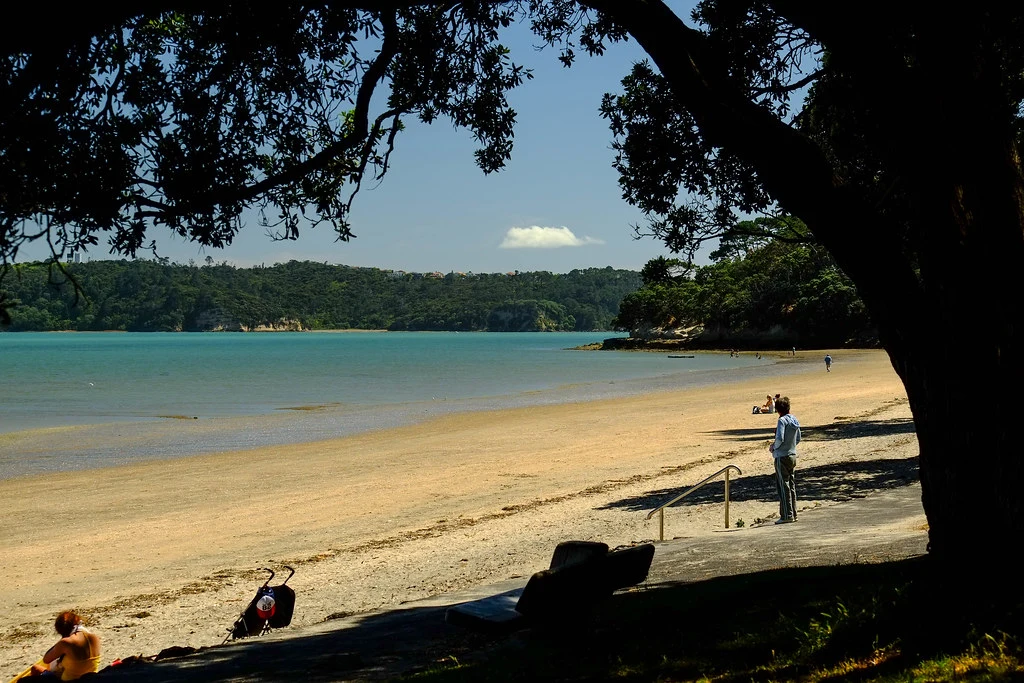
Point Chevalier (Auckland)
Point Chevalier (commonly called Pt Chev) in Auckland is a popular inner-harbour kitesurfing spot that offers flatwater riding and is especially good for beginners and freestyle kiters. Here’s a full breakdown of the kitesurfing conditions at Point Chevalier:
🌬️ Wind Conditions
- Best wind directions: Southwest (SW), West (W), Northwest (NW)
- Average wind strength: 12–20 knots during spring and summer (Oct–Mar)
- Most reliable wind months: November to March, with thermally assisted sea breezes in the afternoons
🌊 Water Conditions
- Flatwater: Ideal for freestyle and learning.
- Water remains shallow for a long distance at low tide, creating slick sections and sandbars.
- No waves—purely flat, tidal water with occasional chop in stronger wind.
🌑 Tides
- Tidal spot: Best ridden two hours before or after low tide.
- At high tide, the water reaches close to the seawall with limited beach space for launching or landing—often not rideable.
- Low tide exposes a wide, hard-packed sandy area perfect for rigging and launching.
🏖️ Beach & Setup Area
- Beach type: Narrow sand/mud beach with grassy rigging area near the car park
- Access: Easy access with parking nearby and direct path to the water
- Hazards: Watch out for shells, sharp debris, and mud at very low tide.
- At mid–high tide, there may be submerged obstacles like rocks or tree roots near the shore.
📍 Location & Orientation
- Situated on the inner side of Auckland’s Waitematā Harbour
- Protected from open ocean swell, offering calm, sheltered waters
- Faces generally northwest, ideal for westerly winds funnelling through the harbour
✅ Ideal For
- Beginners learning in flat, forgiving conditions
- Freestylers looking for slicks and butter-flat water at low tide
- Local sessions close to the city with minimal swell or crowds

Shoal Bay (Auckland)
Shoal Bay in Auckland is a well-known flatwater kitesurfing spot popular with locals. It’s located on the northern side of Auckland’s Waitematā Harbour, near the suburbs of Takapuna and Northcote. Here’s a breakdown of the kitesurfing conditions at Shoal Bay:
🌬️ Wind Conditions
- Best wind directions: Southwest (SW), West (W), Northwest (NW)
- Wind strength: 12–20 knots typically during spring to early autumn (October–March)
- Wind type: Thermal sea breezes and frontal systems
- Notes: Winds can be gusty due to the surrounding hills and buildings
🌊 Water Conditions
- Type: Flatwater, no waves – perfect for freestyle, foiling, and learning
- Chop: Minor chop in strong wind, but mostly smooth
- Sheltered: Located in a shallow tidal estuary, so it’s protected from swell
🌑 Tides
- Very tidal spot – best at mid to low tide
- At high tide: Little to no beach to launch/land, and deeper water makes setup difficult
- At low tide: Wide mudflats/sandbanks are exposed, ideal for launching and flatwater riding
- Use tide charts for Auckland Harbour to plan sessions
🏖️ Beach & Launching Area
- Beach type: Mudflat/sandflat with grassy rigging area nearby
- Access: Via Shoal Bay Road or from the Bayswater Marina side
- Hazards:
- Mud can be slippery or sticky
- Limited launch space at high tide
- Be cautious of buried debris or oyster shells at very low tide
📍 Geographic Orientation
- North-facing estuary on the sheltered side of Auckland Harbour
- Offers scenic views of the city skyline while riding
- Surrounded by urban infrastructure, so wind can be disturbed depending on direction
✅ Best For
- Beginners and freestyle kiters
- Anyone seeking butter-flat water for tricks or foiling
- Those looking for a quick local session near Auckland’s city center
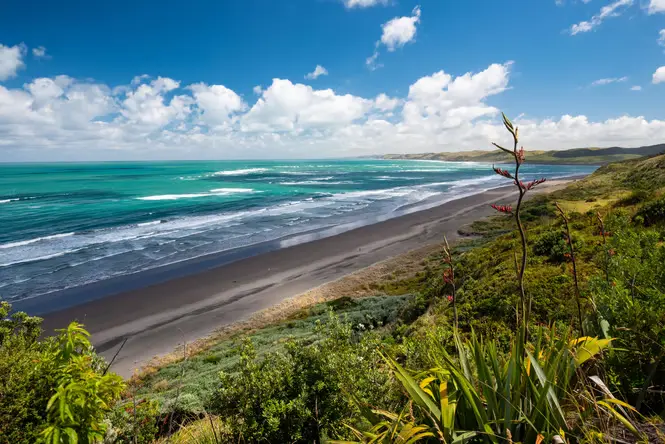
Raglan (Waikato)
Raglan, located in the Waikato region on the west coast of New Zealand’s North Island, is one of the country’s premier wave kitesurfing destinations. It’s known for its powerful ocean swell, consistent winds, and rugged natural beauty. Here’s a detailed breakdown of the kitesurfing conditions:
🌬️ Wind Conditions
- Best wind directions:
- Southwest (SW) – cleanest and most consistent
- West (W), Northwest (NW) – also rideable, but can be gusty
- Wind strength: Generally 12–25 knots, more powerful during spring and summer (October to March)
- Seasonality:
- Spring (Sep–Nov) and summer (Dec–Feb) offer the most reliable winds
- Winter can be stormy and unpredictable but occasionally excellent
🌊 Water Conditions
- Wave spot: Raglan is a world-famous surf destination, with long, peeling left-hand point breaks
- Best suited for: Wave riding – not ideal for beginners unless on smaller surf days
- Chop: Minimal chop between wave sets; wind swell and groundswell often present
🌑 Tides
- Tide-dependent:
- Mid-tide going out is usually best for both surf and space on the beach
- At high tide, the beach can become narrow and dumpy
- Be cautious of strong currents and rips, especially near the river mouth and points
🏖️ Beach & Launching Area
- Primary launch: Ngarunui Beach
- Large, open black-sand beach, with plenty of space to rig and launch
- Watch for beachgoers – kiting is best done away from swimmers and surfers
- Hazards:
- Shore break and strong rips
- Sharp rocks and reef sections near the points
- Crowded surf zones
📍 Geographic Orientation
- West-facing, open to the Tasman Sea – exposed to ocean swell
- Located about 2 hours southwest of Auckland
- The kiting areas are adjacent to world-class surf breaks like Manu Bay, Whale Bay, and Indicators, although kiting directly in these zones is discouraged due to crowds and rocks
✅ Best For
- Advanced wave riders
- Kiters looking to combine surfing and kiting
- Those chasing long, clean waves with side-shore wind
If you’re a beginner or prefer flatwater, Raglan might not be ideal — you’d be better off at estuary spots like Aotea Harbour nearby, or east coast beaches like Papamoa or Omaha.
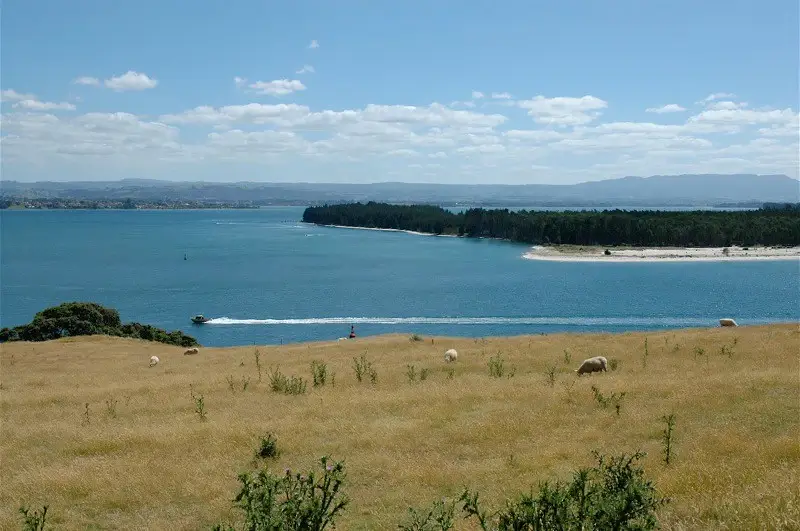
Tauranga / Matakana Island (Bay of Plenty)
Tauranga and Matakana Island, located in the Bay of Plenty on New Zealand’s North Island east coast, offer a diverse and excellent range of kitesurfing conditions, catering to both wave riders and flatwater enthusiasts. Here’s a detailed overview:
🌬️ Wind Conditions
- Best wind directions:
- Northeast (NE), East (E), Southeast (SE) – sea breezes and thermal winds
- Occasionally Southwest (SW) in frontal conditions
- Wind strength: Typically 12–25 knots, most consistent from October to April
- Thermal winds: Especially reliable in summer (Dec–Feb), building through midday
- Gust factor: Generally smooth onshore to side-onshore winds
🌊 Water Conditions
- Matakana Island (Ocean side):
- Long exposed sandbar beaches with consistent beach-break waves
- Good for intermediate to advanced wave riders
- Wide, open beaches make launching and landing easy
- Tauranga Harbour side / Bowentown entrance:
- Offers butter-flat water in estuary channels and sandbanks
- Ideal for freestyle, beginners, and foiling
- Works best at mid to high tide when water covers the sandbanks
🌑 Tides
- Significant tidal range in the Tauranga Harbour
- Timing is crucial:
- Matakana’s surf side: Less affected by tides, but lower tides can expose sandbars
- Harbour/estuary side: Needs sufficient water depth at mid–high tide
- Strong tidal flow at harbour entrances (especially Bowentown and Tauranga Cut)
🏖️ Beach & Launching Area
- Matakana Island:
- Long, open sandy beach on the ocean side – clean, obstacle-free
- Access typically via boat or barge from Tauranga
- Tauranga shore:
- Accessible beaches at Mount Maunganui, Papamoa, and Pilot Bay (mostly for learners or foil boards)
- Bowentown at the southern harbour entrance offers both wave and flatwater options
📍 Geographic Orientation
- East-facing coast on the Pacific Ocean
- Matakana Island sits as a natural barrier between Tauranga Harbour and the ocean, providing sheltered and open options depending on wind and tide
- About 2.5 hours’ drive from Auckland
✅ Best For
- Intermediate to advanced riders seeking waves on Matakana
- Flatwater and beginners in the harbour estuaries
- Those looking for a variety of conditions in one area
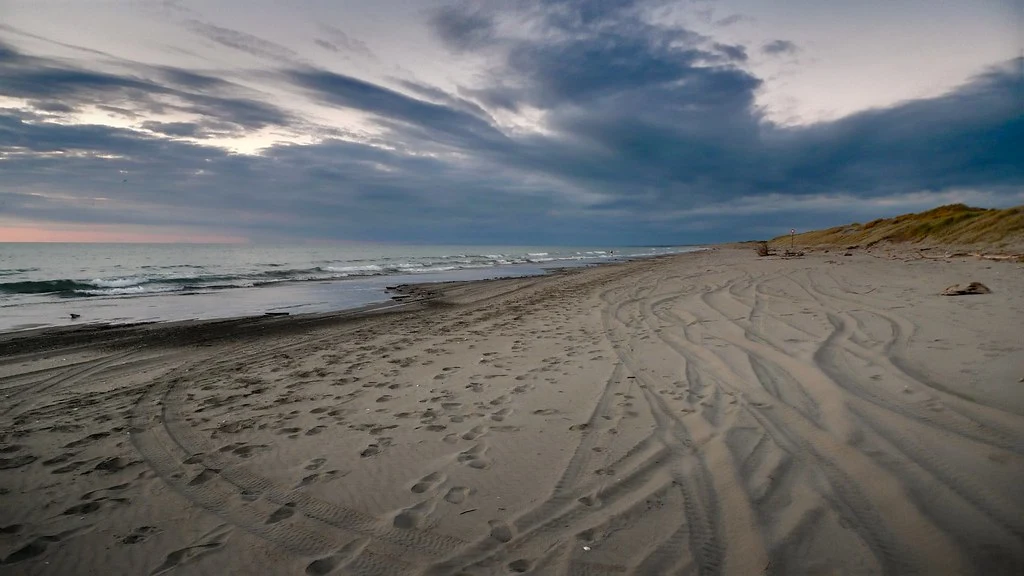
Foxton Beach (Manawatu)
Foxton Beach, located on the west coast of New Zealand’s North Island in the Manawatu-Whanganui region, is a lesser-known but solid kitesurfing destination offering a mix of ocean waves and flatwater estuary conditions. Here’s a breakdown of the kitesurfing setup at Foxton:
🌬️ Wind Conditions
- Best wind directions:
- West (W), Southwest (SW), Northwest (NW) — all sideshore to onshore
- Wind strength:
- Generally 12–25 knots, strongest in spring and summer (Oct–Mar)
- Driven by frontal systems and west coast sea breezes
- Wind type: Mostly clean, but can be gusty on storm fronts
🌊 Water Conditions
- Main beach (Ocean side):
- Exposed west coast beach-break, with consistent medium-size waves
- Good for wave riding and experienced kiters
- Manawatu River estuary (Inland side):
- Offers butter-flat water conditions, ideal for freestyle and beginners
- Works best at mid to high tide — very shallow or dry at low tide
🌑 Tides
- Tide range: Moderate, but significant enough to affect estuary rideability
- Ocean side:
- Works on most tides, but low tide may expose more sandbars
- Estuary side:
- High tide is ideal
- Low tide can leave mudflats and exposed sandbanks
🏖️ Beach & Launching Area
- Foxton Beach (ocean):
- Wide, open sandy beach with plenty of space for rigging and launching
- Minimal beach users compared to urban beaches
- Estuary side:
- Launch from Holben Reserve or near the river mouth
- Be cautious of muddy areas and sharp shells
- Hazards:
- Shorebreak on rougher ocean days
- Estuary has tidal currents and soft-bottomed spots
📍 Geographic Orientation
- West-facing beach exposed to Tasman Sea swells
- Located about 1.5–2 hours north of Wellington and 40 minutes west of Palmerston North
- Well-situated to catch consistent westerlies
✅ Best For
- All levels, depending on the location:
- Estuary: flatwater and beginner-friendly
- Beach: great for intermediate to advanced wave riders
- Kiters looking for an uncrowded west coast alternative to busy spots
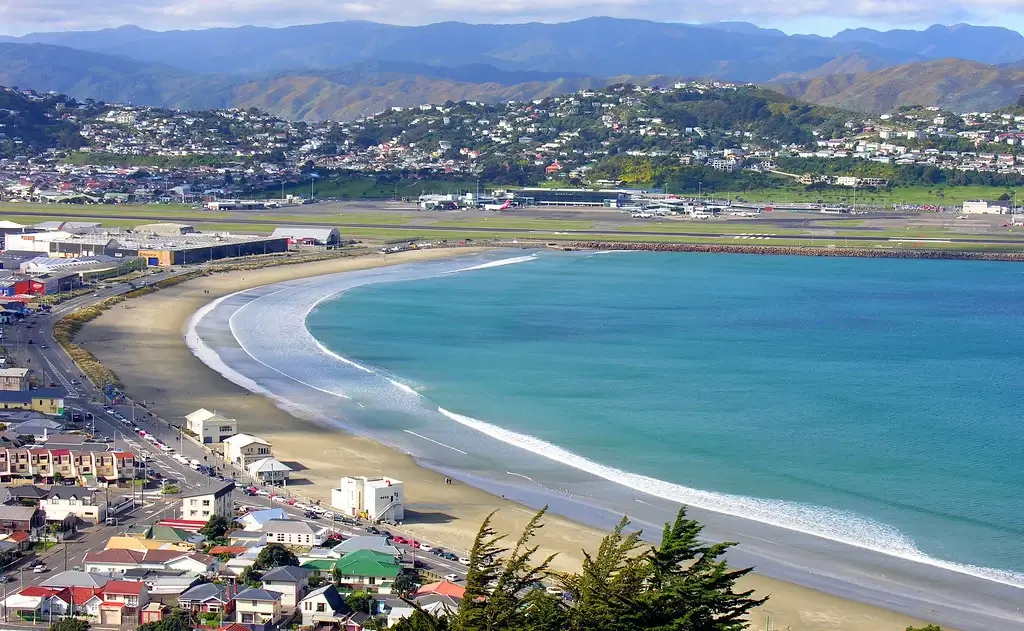
Wellington – Petone & Lyall Bay
Wellington, known as the “Windy City” of New Zealand, offers excellent and diverse kitesurfing conditions, particularly at Petone Beach and Lyall Bay. These two spots cater to different riding styles — flatwater vs. waves — depending on wind direction, tide, and your experience level.
Petone Beach (Wellington Harbour – North Side)
🌬️ Wind Conditions
- Best directions: Northwest (NW) and North (N)
- Wind strength: Consistent 15–30 knots during spring and summer (Oct–Mar)
- Wind is generally onshore to cross-onshore here
🌊 Water Conditions
- Flatwater to slight chop – perfect for freestyle, beginners, and foiling
- Sheltered harbour location, so no swell, but wind chop possible in strong winds
🌑 Tides
- Petone is very tide-sensitive:
- High tide: limited beach space for setup
- Mid to low tide: ideal for launching and riding (wide sandflats exposed)
🏖️ Beach & Access
- Sandy beach with lots of space at low tide
- Large grassy rigging area behind the beach
- Easy access, but watch out for muddy patches at very low tide
✅ Best For
- Beginners to intermediate riders
- Freestyle and foil kiting
- Great when the northwesterlies are blowing strong in the harbour
Lyall Bay (South Coast – Surf Beach)
🌬️ Wind Conditions
- Best directions: Northwest (NW), West (W), South (S)
- Wind can be very strong, gusty, and colder
- Side-onshore on a NW, which is most common
🌊 Water Conditions
- Consistent beach-break waves – ideal for wave riding
- Often head-high swell, cleanest on a light NW
🌑 Tides
- Tide-independent, but high tide can reduce beach space
- Low to mid tide offers the best launching space
🏖️ Beach & Access
- Long sandy beach with good room to rig
- Can be busy with surfers, swimmers, and beachgoers
- Nearby car parks, surf shops, and cafes
✅ Best For
- Intermediate to advanced wave riders
- Those looking for a challenge and consistent wind
- Avoid onshore days if inexperienced due to waves and crowding
📍 Summary
| Location | Water Type | Best For | Wind Direction | Tide Sensitivity |
|---|---|---|---|---|
| Petone | Flatwater | Beginners/Freestyle | NW, N | High |
| Lyall Bay | Waves | Wave riders | NW, W, S | Low-mid ideal |
🏄♂️ South Island
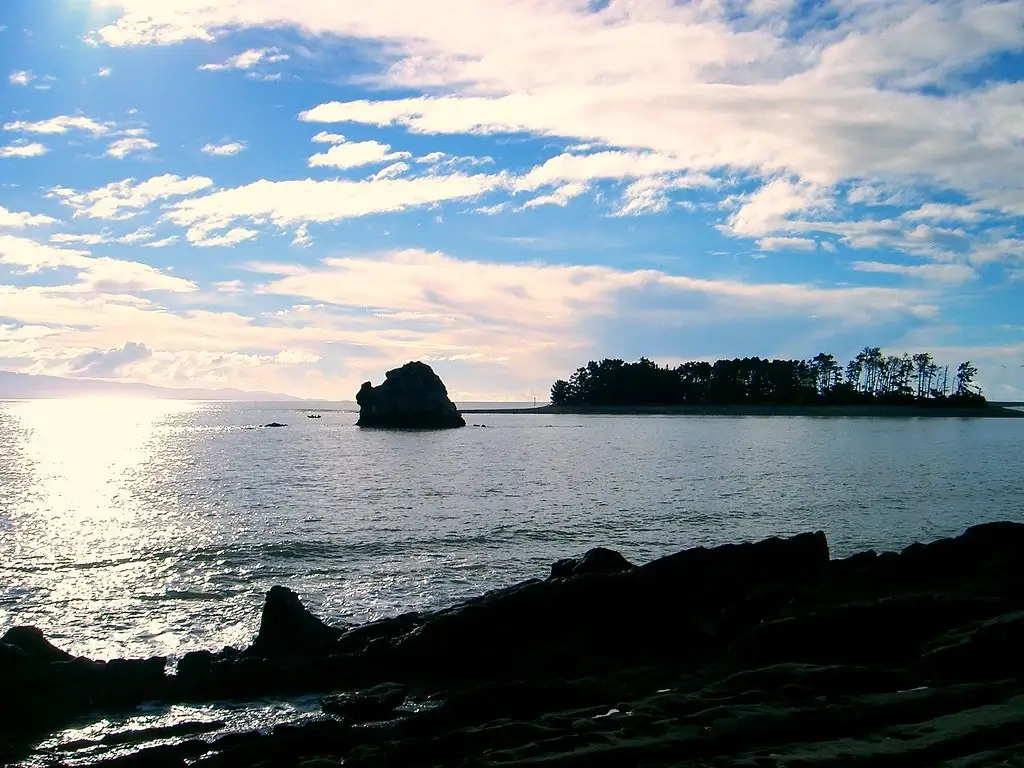
Tahunanui Beach (Nelson)
The South Island also houses some of the best kitesurfing spots in New Zealand. Tahunanui Beach in Nelson, located at the top of New Zealand’s South Island, is a scenic and beginner-friendly kitesurfing spot offering mostly flatwater conditions and consistent thermal winds. Here’s a detailed breakdown of the kiting conditions:
🌬️ Wind Conditions
- Best wind directions:
- North (N), Northeast (NE), Northwest (NW) — cross-onshore and side-shore
- Wind type:
- Sea breezes develop on warm, sunny days — reliable in spring through autumn (Oct–Apr)
- Average strength: 12–20 knots; occasionally stronger during frontal systems
- Thermal effect: Often kicks in late morning/early afternoon
🌊 Water Conditions
- Flat to slightly choppy water
- Ideal for freestyle, freeride, and beginner lessons
- On stronger wind days, light wind chop can build — still safe and manageable
- Shallow water for a long distance out at low tide — excellent for learning
- No significant waves due to the sheltered nature of Tasman Bay
🌑 Tides
- Tide-sensitive spot:
- Mid to high tide is best for riding; more water over the sandbanks
- Low tide can expose mudflats and make launching tricky or unrideable in parts
🏖️ Beach & Launch Area
- Wide sandy beach with plenty of space, especially at low tide
- Designated kiting launch zones help separate riders from swimmers
- Grass areas nearby for setup and rigging
- Well-facilitated with parking, toilets, and nearby cafes
📍 Geographic Orientation
- Located on the Tasman Bay, facing northward
- Sheltered from major ocean swell due to surrounding land masses — keeps water flat
- Nelson is known for having New Zealand’s sunniest weather, supporting frequent thermal winds
✅ Best For
- Beginners, freestyle riders, foilers
- Families or casual kiters wanting a safe and comfortable location
- No waves – not ideal for wave riding
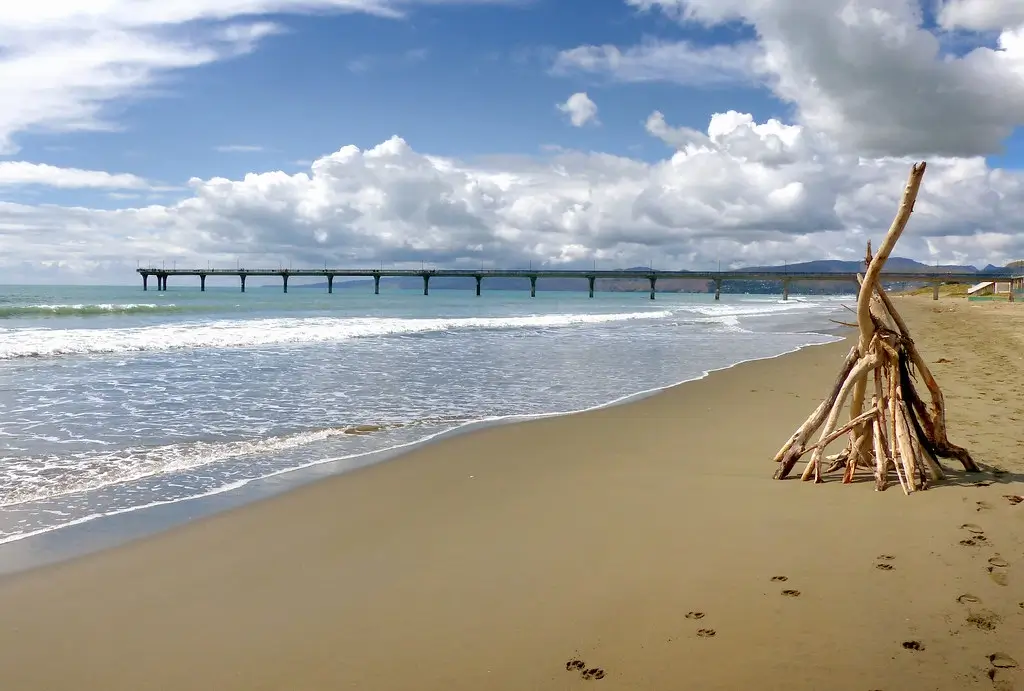
Christchurch – New Brighton Beach
New Brighton Beach, located on the east coast of New Zealand’s South Island in Christchurch, is a solid kitesurfing spot for those who enjoy wave riding and consistent wind. Here’s a detailed breakdown of the conditions:
🌬️ Wind Conditions
- Best wind directions:
- Northeast (NE) – most common in summer
- Easterly (E) and southeasterly (SE) also work well
- Wind strength:
- Typically 12–25 knots, often driven by thermal and sea breeze effects
- Strongest in spring through autumn (Oct–Apr)
- Winds are usually side-onshore or onshore, depending on direction
🌊 Water Conditions
- Open ocean beach-break with consistent waves
- Wave size: Generally 0.5 to 2 meters, bigger on strong swell days
- Suitable for wave riding and downwinders
- Conditions can be choppy with onshore winds but very rideable
🌑 Tides
- Tide-independent, rideable on all tides
- At low tide, more beach space but slightly longer walk to the water
- High tide brings waves closer to shore — watch for shorebreak
🏖️ Beach & Launching Area
- Long, wide sandy beach – ideal for rigging and launching
- Ample room to spread out, even on busy days
- Access from multiple points along the beach, with car parks and amenities nearby
- Watch for swimmers and surfers, especially near the pier
📍 Geographic Orientation
- Faces east into the Pacific Ocean
- Picks up consistent swell from the south and southeast
- Easily accessible from central Christchurch (15–20 minutes’ drive)
✅ Best For
- Intermediate to advanced riders
- Beginners can ride on lighter days but must be cautious of waves
- Wave riders, downwinders, and freeriders
- Kiters looking for open ocean conditions near an urban area
⚠️ Local Tips & Cautions
- Avoid the area near the New Brighton Pier, especially when crowded
- Be aware of rips and strong currents on big swell days
- Wetsuit needed most of the year — water temps range from 11–17°C
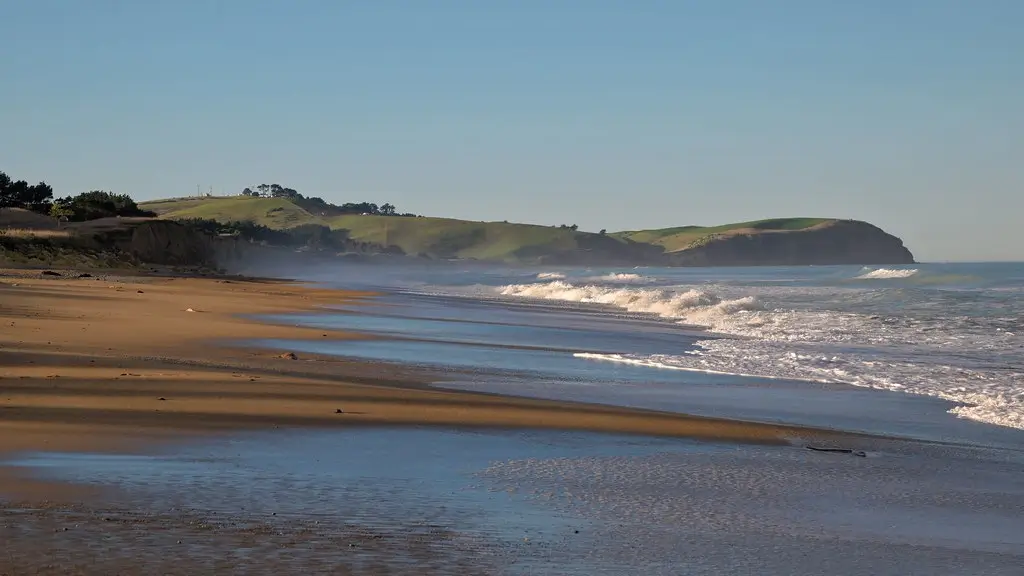
St. Kilda & St. Clair (Dunedin)
St. Kilda and St. Clair Beaches in Dunedin, on New Zealand’s southeast coast, offer a powerful and raw kitesurfing experience, ideal for riders who are comfortable in open ocean conditions. These beaches are side-by-side and share similar characteristics.
🌬️ Wind Conditions
- Best wind directions:
- Northeast (NE) and East (E) – cross-onshore
- Northwest (NW) can work but is often gusty due to hills
- Wind strength:
- Commonly 15–25 knots in spring and summer
- Can get very strong and gusty during frontal systems (especially in winter)
🌊 Water Conditions
- Wave conditions:
- Consistent beach-break waves due to strong Southern Ocean swells
- Wave size ranges from 1 to 3+ meters, making it ideal for wave riding
- Expect strong shorebreak and rip currents, especially at high tide or during large swells
- Not suitable for flatwater riding – this is a wave spot
- No sheltered lagoons or estuaries nearby
🌑 Tides
- Rideable on all tides, but conditions vary:
- Low to mid tide: More beach space, smaller shorebreak
- High tide: Closer and stronger shorebreak; less room for launch
- Strong rip currents often occur during outgoing tide with swell
🏖️ Beach & Launch Area
- Long, wide sandy beaches — plenty of space for launching and landing
- Urban access with car parks, cafes, and toilets nearby
- St. Kilda is quieter; St. Clair has more foot traffic, swimmers, and surfers
📍 Geographic Orientation
- Faces southeast, directly exposed to the Southern Ocean
- Open to consistent swells — often head-high or bigger
- Backed by dunes and some residential areas; generally easy access
✅ Best For
- Intermediate to advanced kitesurfers
- Wave riders looking for powerful swell and wind
- Kiters who can handle strong current and dynamic beach-break conditions
⚠️ Local Tips & Hazards
- Wear a wetsuit year-round – water temps range from 8°C in winter to 14°C in summer
- Rip currents are common — know how to spot and escape them
- Avoid areas heavily used by surfers and swimmers near the St. Clair Esplanade
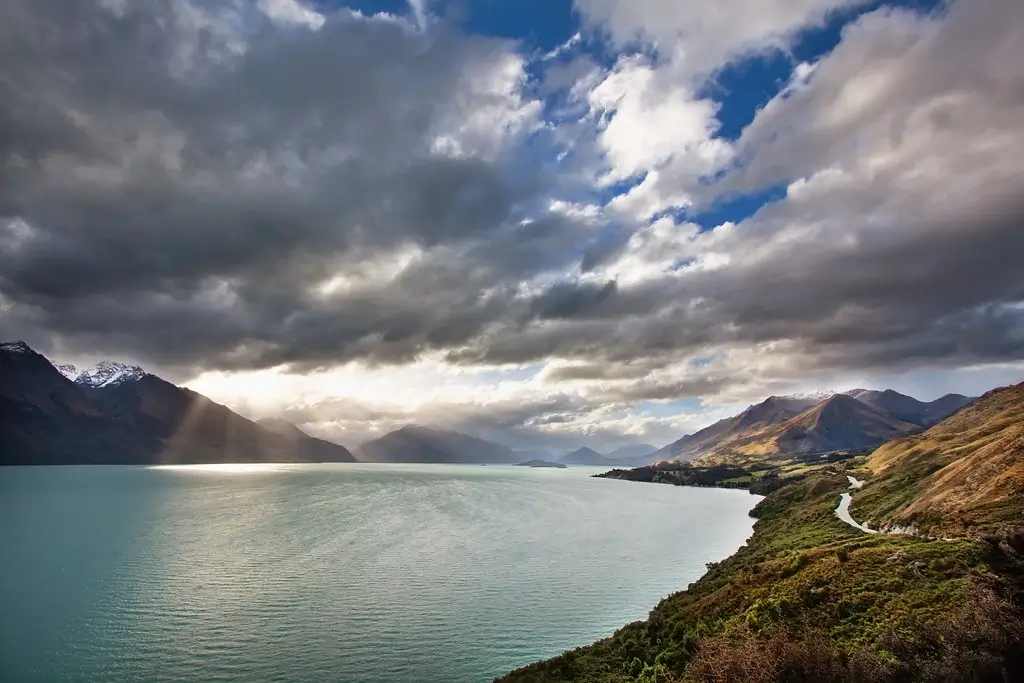
Lake Wakatipu (Queenstown – Frankton Arm)
Lake Wakatipu, located in the Southern Alps near Queenstown, is a stunning and unique inland kitesurfing destination in New Zealand. Surrounded by mountains and fed by glaciers, it offers a freshwater flatwater riding experience—but with some specific considerations.
🌬️ Wind Conditions
- Wind type:
- Thermal and valley winds, typically from northwest (NW) or westerly directions
- Wind strength:
- Varies greatly, typically 10–20 knots on a good day, but can be gusty
- Winds are less reliable and more localized than coastal spots
- Best winds usually in spring to autumn (Oct–Apr), in the afternoons
- Can be gusty due to the mountainous terrain
🌊 Water Conditions
- Flat to slightly choppy freshwater
- No waves – ideal for freestyle, freeride, and foiling
- Water is crystal clear but very cold, especially outside summer
- No swell or current, but wind-driven chop can develop
🌑 Tides
- No tidal influence, as it’s a freshwater lake
- Water levels can change with snowmelt and rainfall but do not affect rideability much
🏖️ Beach & Launching Areas
- Several launch spots around the lake, most notably:
- Glenorchy (northwest tip) – most popular for kitesurfing
- Kingston (southern end)
- Frankton Arm (closer to Queenstown) – limited space, wind can be blocked
- Beaches are often narrow and rocky or pebbled, not soft sand
- Launching can be tricky; bring a kite buddy or use assisted launching if available
📍 Geographic Orientation
- A long, Z-shaped alpine lake oriented roughly northeast to southwest
- Surrounded by steep mountain ranges, which can channel or block wind
- Glenorchy area is most exposed to prevailing westerly winds from the Southern Alps
✅ Best For
- Experienced kiters, due to gusty conditions and limited launch space
- Riders looking for flatwater, scenic alpine surroundings, and a challenge
- Freestyle and foil kiting, not wave riding
⚠️ Local Tips & Hazards
- Wetsuit essential year-round – water rarely exceeds 12–14°C in summer
- Gusty wind means extra caution when launching or self-landing
- No rescue service – be prepared and ride within your limits
- Bring your own gear – very few local kite shops or schools in the region